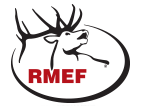
Colorado elk herd in the crosshairs
by RMEF
1-18-2017

The Rocky Mountain Elk Foundation is raising a word of warning about a “quiet” movement in Colorado seeking to place wolves on the landscape. It also has grave concerns about the tactics used by environmentalists and animal rights groups behind such efforts.
A representative of a wolf advocacy group, the Turner Endangered Species Fund, recently addressed a gathering of Colorado citizens claiming the placement of wolves on the Colorado landscape is “most germane” to the state’s future, and added “there’s no downside and there’s a real big upside.”
RMEF strongly disputes those claims.
“Wolves have a measureable and oftentimes detrimental impact on big game management wherever they go. Their reintroduction into the Northern Rocky Mountains led to a reduction of the Northern Yellowstone herd by more than 80 percent,” said David Allen, RMEF president and CEO. “Among other things, wolves also greatly reduced elk numbers to dangerously low levels in central Idaho and have a profound impact on declining moose and deer populations in the Western Great Lakes region.”
The Northern Yellowstone Elk herd numbered more than 19,000 before wolf reintroduction in the mid-1990s but dropped below 4,000 in 2012. Increasing grizzly, black bear and mountain lion populations also played a role in the decline. Minnesota’s moose population numbered approximately 8,840 in 2006 but since dropped 55 percent to an estimated 4,020 in 2016.
“We have also witnessed time and time again that pro-wolf groups seek to ignore agreed upon population recovery goals, thus moving the goals posts, so to speak, by filing obstructionist lawsuits designed to drag out or deny the delisting process altogether and allowing wolf populations to soar well above agreed upon levels,” said Allen. “These groups totally ignore what they themselves agree to once they get wolves on the landscape and they use lawsuits to manipulate the system, ignoring state-based management. And, in many cases the American taxpayers are paying for their legal fees,” Allen added.
Animal rights groups filed at least nine lawsuits regarding wolf populations in the Northern Rockies and at least six others affecting wolves in the Western Great Lakes, as well as several others that have impacted the listing status of wolves across the contiguous 48 states. Currently, two cases are pending in the D.C. Circuit Court of Appeals, affecting listing status in Wyoming and in the Western Great Lake states.
As part of the wolf reintroduction efforts in the mid-1990s, federal and state agencies agreed to delist wolves and place them under state management when the original minimum recovery levels reached 100 wolves each in Idaho, Montana and Wyoming. Wolves met those delisting standards in 2002 but 2015 minimum populations were nearly 500 percent above that—786 in Idaho, 536 in Montana and 382 in Wyoming. The original population objective for wolves in the Western Great Lakes was 1,350 but at last count the overall minimum population numbered greater than 3,600.
Though well above minimum population levels, federal protections remain in place for wolves in the Western Great Lakes region and Wyoming due to environmental lawsuits.
“An unhealthy and litigious precedent has been set that once pro-wolf groups get a foot in the reintroduction door, they kick it open and file lawsuit after lawsuit to stymie the delisting process while using the wolf as a fundraising tool. Colorado’s elk population will be next in the crosshairs,” cautioned Allen. ”And by the way wolves are nowhere near endangered.”
About the Rocky Mountain Elk Foundation:
Founded over 30 years ago, fueled by hunters and a membership of nearly 220,000 strong, RMEF has conserved more than 6.9 million acres for elk and other wildlife. RMEF also works to open and improve public access, fund and advocate for science-based resource management, and ensure the future of America’s hunting heritage. Discover why "Hunting Is Conservation™" at www.rmef.org or 800-CALL ELK.
Website Hosting and Design provided by TECK.net